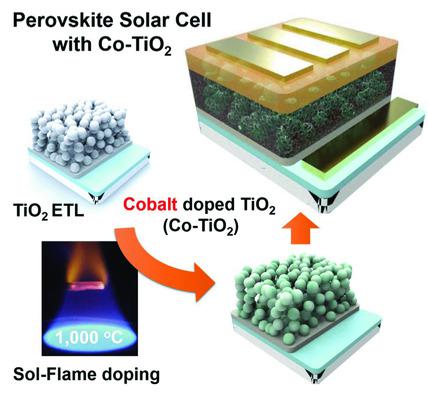当前位置:
X-MOL 学术
›
Adv. Energy Mater.
›
论文详情
Our official English website, www.x-mol.net, welcomes your
feedback! (Note: you will need to create a separate account there.)
Resolving Hysteresis in Perovskite Solar Cells with Rapid Flame‐Processed Cobalt‐Doped TiO2
Advanced Energy Materials ( IF 24.4 ) Pub Date : 2018-08-29 , DOI: 10.1002/aenm.201801717 Jung Kyu Kim 1, 2 , Sung Uk Chai 3 , Yongfei Ji 4, 5 , Ben Levy-Wendt 2 , Suk Hyun Kim 5, 6 , Yeonjin Yi 7 , Tony F. Heinz 5, 6 , Jens K. Nørskov 4, 5 , Jong Hyeok Park 3 , Xiaolin Zheng 2
Advanced Energy Materials ( IF 24.4 ) Pub Date : 2018-08-29 , DOI: 10.1002/aenm.201801717 Jung Kyu Kim 1, 2 , Sung Uk Chai 3 , Yongfei Ji 4, 5 , Ben Levy-Wendt 2 , Suk Hyun Kim 5, 6 , Yeonjin Yi 7 , Tony F. Heinz 5, 6 , Jens K. Nørskov 4, 5 , Jong Hyeok Park 3 , Xiaolin Zheng 2
Affiliation

|
To further increase the open‐circuit voltage (V
oc) of perovskite solar cells (PSCs), many efforts have been devoted to doping the TiO2 electron transport/selective layers by using metal dopants with higher electronegativity than Ti. However, those dopants can introduce undesired charge traps that hinder charge transport through TiO2, so the improvement in the V
oc is often accompanied by an undesired photocurrent density–voltage (J–V) hysteresis problem. Herein, it is demonstrated that the use of a rapid flame doping process (40 s) to introduce cobalt dopant into TiO2 not only solves the J–V hysteresis problem but also increases the V
oc and power conversion efficiency of both mesoscopic and planar PSCs. The reasons for the simultaneous improvements are two fold. First, the flame‐doped Co‐TiO2 film forms Co‐Ov (cobalt dopant‐oxygen vacancy) pairs and hence reduces the number density of Ti3+ trap states. Second, Co doping upshifts the band structure of TiO2, facilitating efficient charge extraction. As a result, for planar PSCs, the flame doping of Co increases the efficiency from 17.1% to 18.0% while reducing the hysteresis from 16.0% to 1.7%. Similarly, for mesoscopic PSCs, the flame doping of Co increases the efficiency from 18.5% to 20.0% while reducing the hysteresis from 7.0% to 0.1%.
中文翻译:

用快速火焰处理的钴掺杂二氧化钛解决钙钛矿太阳能电池中的滞后现象
为了进一步提高钙钛矿太阳能电池(PSC)的开路电压(V oc),人们已经进行了许多努力,通过使用电负性比Ti高的金属掺杂剂来掺杂TiO 2电子传输/选择层。但是,这些掺杂剂会引入不希望有的电荷陷阱,从而阻碍电荷通过TiO 2的传输,因此V oc的提高通常伴随着不希望有的光电流密度-电压(J-V)滞后问题。本文证明,使用快速火焰掺杂工艺(40 s)将钴掺杂剂引入TiO 2不仅解决了J–V迟滞问题,但同时也增加了介观和平面PSC的V oc和功率转换效率。同时进行改进的原因有两个。首先,掺有火焰的Co-TiO 2薄膜形成Co-O v(钴掺杂氧空位)对,因此降低了Ti 3+陷阱态的数密度。其次,Co掺杂使TiO 2的能带结构上移,促进高效电荷提取。结果,对于平面PSC,Co的火焰掺杂将效率从17.1%提高到18.0%,同时将磁滞从16.0%降低到1.7%。类似地,对于介观的PSC,Co的火焰掺杂将效率从18.5%提高到20.0%,同时将磁滞从7.0%降低到0.1%。
更新日期:2018-08-29
中文翻译:

用快速火焰处理的钴掺杂二氧化钛解决钙钛矿太阳能电池中的滞后现象
为了进一步提高钙钛矿太阳能电池(PSC)的开路电压(V oc),人们已经进行了许多努力,通过使用电负性比Ti高的金属掺杂剂来掺杂TiO 2电子传输/选择层。但是,这些掺杂剂会引入不希望有的电荷陷阱,从而阻碍电荷通过TiO 2的传输,因此V oc的提高通常伴随着不希望有的光电流密度-电压(J-V)滞后问题。本文证明,使用快速火焰掺杂工艺(40 s)将钴掺杂剂引入TiO 2不仅解决了J–V迟滞问题,但同时也增加了介观和平面PSC的V oc和功率转换效率。同时进行改进的原因有两个。首先,掺有火焰的Co-TiO 2薄膜形成Co-O v(钴掺杂氧空位)对,因此降低了Ti 3+陷阱态的数密度。其次,Co掺杂使TiO 2的能带结构上移,促进高效电荷提取。结果,对于平面PSC,Co的火焰掺杂将效率从17.1%提高到18.0%,同时将磁滞从16.0%降低到1.7%。类似地,对于介观的PSC,Co的火焰掺杂将效率从18.5%提高到20.0%,同时将磁滞从7.0%降低到0.1%。











































 京公网安备 11010802027423号
京公网安备 11010802027423号